Comparison of the Emissions, Noise, and Fuel Consumption Comparison of Direct and Indirect Piezoelectric and Solenoid Injectors in a Low-Compression-Ratio Diesel Engine
Abstract
1. Introduction
2. Experimental Setup and Engine Conditions
3. Injector Hydraulic Performance
4. Results and Discussion
4.1. Low Load and Speed (1500 × 2)
4.2. Medium–High Speed and Load (2000 × 5, 2500 × 8)
5. Conclusions
Author Contributions
Funding
Conflicts of Interest
Abbreviations
| bmep | brake mean effective pressure |
| bsfc | brake specific fuel consumption |
| bTDC | before Top Dead Center |
| CA | crank angle (deg) |
| CLD | Chemiluminescence Detector |
| CN | Combustion Noise |
| CR | Common Rail |
| DAP | Direct-Acting Piezoelectric |
| EGR | Exhaust Gas Recirculation |
| ET | Energizing Time |
| ETPil | Energizing Time of the pilot injection |
| HC | unburned hydrocarbons |
| HFID | Heated Flame Ionization Detector |
| HRR | Heat Release Rate |
| HRRpk1 | Peak of the Heat Release rate for pilot combustion |
| HRRpk2 | Peak of the Heat Release rate for main combustion |
| IAP | Indirect-Acting Piezoelectric |
| IAS | Indirect-Acting Solenoid |
| ID | Ignition Delay |
| n | Rotational speed of the engine |
| NDIR | Non-Dispersive Infrared detector |
| NOx | nitrogen oxides |
| OEM | Original Equipment Manufacturer |
| p | pressure [bar] |
| PCCI | Premixed Charge Compression Ignition |
| pM | pilot + main double fuel injection strategy |
| prail | fuel rail pressure |
| q | fuel injected volume per stroke and per cylinder |
| qPil | fuel injected volume of the pilot injection |
| SOI | electric Start of Injection |
| SOIMain | electric Start of Injection of the main injection |
| SOIPil | electric Start of Injection of the pilot injection |
| TDC | Top Dead Center |
| XEGR | EGR rate |
| Greek symbols | |
| θ | Rotational angle of the crankshaft |
References
- Finesso, R.; Hardy, G.; Mancarella, A.; Marello, O.; Mittica, A.; Spessa, E. Real-time simulation of torque and nitrogen oxide emissions in an 11.0 L heavy-duty diesel engine for model-based combustion control. Energies 2019, 12, 460. [Google Scholar] [CrossRef]
- Catania, A.; Ferrari, A.; Mittica, A.; Spessa, E. Common rail without accumulator: Development, theoretical-experimental analysis and performance enhancement at DI-HCCI level of a new generation FIS. In SAE Technical Paper 2007-01-1258; SAE International: Warrendale, PA, USA, 2007. [Google Scholar] [CrossRef]
- Catania, A.; Ferrari, A.; Mittica, A. High-pressure rotary pump performance in multi-jet common rail systems. In Proceedings of 8th Biennial ASME Conference on Engineering Systems Design and Analysis, Torino, Italy, 4–7 July 2006. [Google Scholar] [CrossRef]
- Ferrari, A.; Mittica, A.; Pizzo, P.; Jin, Z. PID Controller Modelling and Optimization in CR Systems with Standard and Reduced Accumulators. Int. J. Automot. Technol. 2018, 19, 771–781. [Google Scholar] [CrossRef]
- Nikzadfar, K.; Shamekhi, A.H. More than one decade with development of common-rail diesel engine management systems: A literature review on modelling, control, estimation and calibration. Proc. Inst. Mech. Eng. Part D J. Automob. Eng. 2015, 229, 1110–1142. [Google Scholar] [CrossRef]
- Musculus, M.P.B.; Pickett, L.M. 17—In-cylinder spray, mixing, combustion, and pollutant-formation processes in conventional and low-temperature-combustion diesel engines. In Advanced Direct Injection Combustion Engine Technologies and Development; Woodhead Publishing: Cambridge, UK, 2010; Volume 2, pp. 644–675. ISBN 9781845697440. [Google Scholar] [CrossRef]
- Leach, F.; Ismail, R.; Davy, M. Engine-out emissions from a modern high speed diesel engine—The importance of Nozzle Tip Protrusion. Appl. Energy 2018, 226, 340–352. [Google Scholar] [CrossRef]
- Ferrari, A.; Mittica, A. Response of different injector typologies to dwell time variations and a hydraulic analysis of closely-coupled and continuous rate shaping injection schedules. Appl. Energy 2016, 169, 899–911. [Google Scholar] [CrossRef]
- Ferrari, A.; Mittica, A.; Pizzo, P.; Wu, X.; Zhou, H. New methodology for the identification of the leakage paths and guidelines for the design of common rail injectors with reduced leakage. J. Eng. Gas Turbines Power 2018, 140, 022801. [Google Scholar] [CrossRef]
- Ferrari, A.; Mittica, A.; Paolicelli, F.; Pizzo, P. Hydraulic Characterization of Solenoid-actuated Injectors for Diesel Engine Common Rail Systems. Energy Procedia 2016, 101, 878–885. [Google Scholar] [CrossRef]
- Huber, B.; Ulbrich, H. Modeling and Experimental Validation of the Solenoid Valve of a Common Rail Diesel Injector. SAE Technical Paper 2014-01-0195. 2014. Available online: https://www.sae.org/publications/technical-papers/content/2014-01-0195/ (accessed on 23 October 2019). [CrossRef]
- Ferrari, A.; Mittica, A. FEM modeling of the piezoelectric driving system in the design of direct-acting diesel injectors. Appl. Energy 2012, 99, 471–483. [Google Scholar] [CrossRef]
- Fettes, C.; Leipertz, A. Potential of a Piezo-Driven Passenger Car Common-Rail System to Meet Future Emission Legislations—An Evaluation by Means of in-Cylinder Analysis of Injection and Combustion. SAE Technical Paper 2001-01-3499. 2001. Available online: https://www.sae.org/publications/technical-papers/content/2001-01-3499/ (accessed on 23 October 2019). [CrossRef]
- Magno, A.; Mancaruso, E.; Sequino, L.; Vaglieco, M.B. Analysis of spray evolution from both piezo and solenoid injectors in single cylinder research engine. In Proceedings of the 25th European Conference on Liquid Atomization and Spray Systems ILASS-2013, Chania, Greece, 1–4 September 2013. [Google Scholar]
- Koyanagi, K.; Oing, H.; Renner, G.; Maly, R. Optimizing Common Rail Injection by Optical Diagnostics in a Transparent Production Type Diesel Engine. SAE Technical Paper 1999-01-3646. 1999. Available online: https://www.sae.org/publications/technical-papers/content/1999-01-3646/ (accessed on 23 October 2019). [CrossRef]
- Ueda, D.; Tanada, H.; Utsunomiya, A.; Kawamura, J.; Weber, J. 4th Generation Diesel Piezo Injector (Realizing Enhanced High Response Injector. SAE Technical Paper 2016-01-0846. 2016. Available online: https://www.sae.org/publications/technical-papers/content/2016-01-0846/ (accessed on 23 October 2019). [CrossRef]
- Kim, J.; Kim, J.; Jeong, S.; Han, S.; Lee, J. Effects of different piezo-acting mechanism on two-stage fuel injection and CI combustion in a CRDi engine. J. Mech. Sci. Technol. 2016, 30, 5727–5737. [Google Scholar] [CrossRef]
- Suh, K.H.; Lee, C.S. Experimental and Numerical Analysis of Diesel Fuel Atomization Characteristics of a Piezo Injection System. Oil Gas Sci. Technol. Rev. IFP 2008, 63, 239–250. [Google Scholar] [CrossRef][Green Version]
- Ferrari, A.; Mittica, A.; Spessa, E. Benefits of hydraulic layout over driving system in piezo-injectors and proposal of a new-concept CR injector with an integrated Minirail. Appl. Energy 2012, 103, 243–255. [Google Scholar] [CrossRef]
- Jorach, R.W.; Bercher, P.; Meissonnier, G.; Milanovic, N. Common rail system from Delphi with solenoid valves and single plunger pump. Auto Tech Rev. 2012, 1, 38–43. [Google Scholar] [CrossRef]
- Matsumoto, S.; Date, K.; Taguchi, T.; Herrmann, O.E. The new Denso common rail diesel solenoid injector. Auto Tech Rev. 2013, 2, 24–29. [Google Scholar] [CrossRef]
- D’Ambrosio, S.; Ferrari, A. Diesel engines equipped with piezoelectric and solenoid injectors: Hydraulic performance of the injectors and comparison of the emissions, noise and fuel consumption. Appl. Energy 2018, 211, 1324–1342. [Google Scholar] [CrossRef]
- D’Ambrosio, S.; Ferrari, A. Direct Versus Indirect Acting Piezoelectric CR Injectors: Comparison of Hydraulic Performance, Pollutant Emissions, Combustion Noise, and Fuel Consumption. SAE Int. J. Engines 2018, 11, 585–612. [Google Scholar] [CrossRef]
- Delphi Automotive. Direct Acting Light-Duty Diesel CR System; Technical Report; Delphi Automotive: Dublin, Ireland, 2008. [Google Scholar]
- D’Ambrosio, S.; Ferrari, A. Effects of exhaust gas recirculation in diesel engines featuring late PCCI type combustion strategies. Energy Convers. Manag. 2015, 105, 1269–1280. [Google Scholar] [CrossRef]
- D’Ambrosio, S.; Finesso, R.; Spessa, E. Calculation of mass emissions, oxygen mass fraction and thermal capacity of the inducted charge in SI and diesel engines from exhaust and intake gas analysis. Fuel 2011, 90, 152–166. [Google Scholar] [CrossRef]
- D’Ambrosio, S.; Finesso, R.; Lezhong, F.; Mittica, A.; Spessa, E. A control-oriented real-time semi-empirical model for the prediction of NOx emissions in diesel engines. Appl. Energy 2014, 130, 265–279. [Google Scholar] [CrossRef]
- D’Ambrosio, S.; Ferrari, A. Potential of double pilot injection strategies optimized with the design of experiments procedure to improve diesel engine emissions and performance. Appl. Energy 2015, 155, 918–932. [Google Scholar] [CrossRef]
- Curran, H.J.; Gaffuri, P.; Pitz, W.J.; Westbrook, C.K. A Comprehensive Modeling Study of n-Heptane Oxidation. Combust. Flame 1998, 114, 149–177. [Google Scholar] [CrossRef]
- Goldsborough, S.S. A chemical kinetically based ignition delay correlation for iso-octane covering a wide range of conditions including the NTC region. Combust. Flame 2009, 156, 1248–1262. [Google Scholar] [CrossRef]
- Kiplimo, R.; Tomita, E.; Kawahara, N.; Yokobe, S. Effects of spray impingement, injection parameters, and EGR on the combustion and emission characteristics of a PCCI diesel engine. Appl. Therm. Eng. 2011, 37, 165–175. [Google Scholar] [CrossRef]
- Selim, M. Effect of exhaust gas recirculation on some combustion characteristics of dual fuel engine. Energy Convers. Manag. 2003, 44, 707–721. [Google Scholar] [CrossRef]
- D’Ambrosio, S.; Ferrari, A.; Iemmolo, D.; Mittica, A. Dependence of combustion noise on engine calibration parameters by means of the response surface methodology in passenger car diesel engines. Appl. Therm. Eng. 2019, 163, 114209. [Google Scholar] [CrossRef]
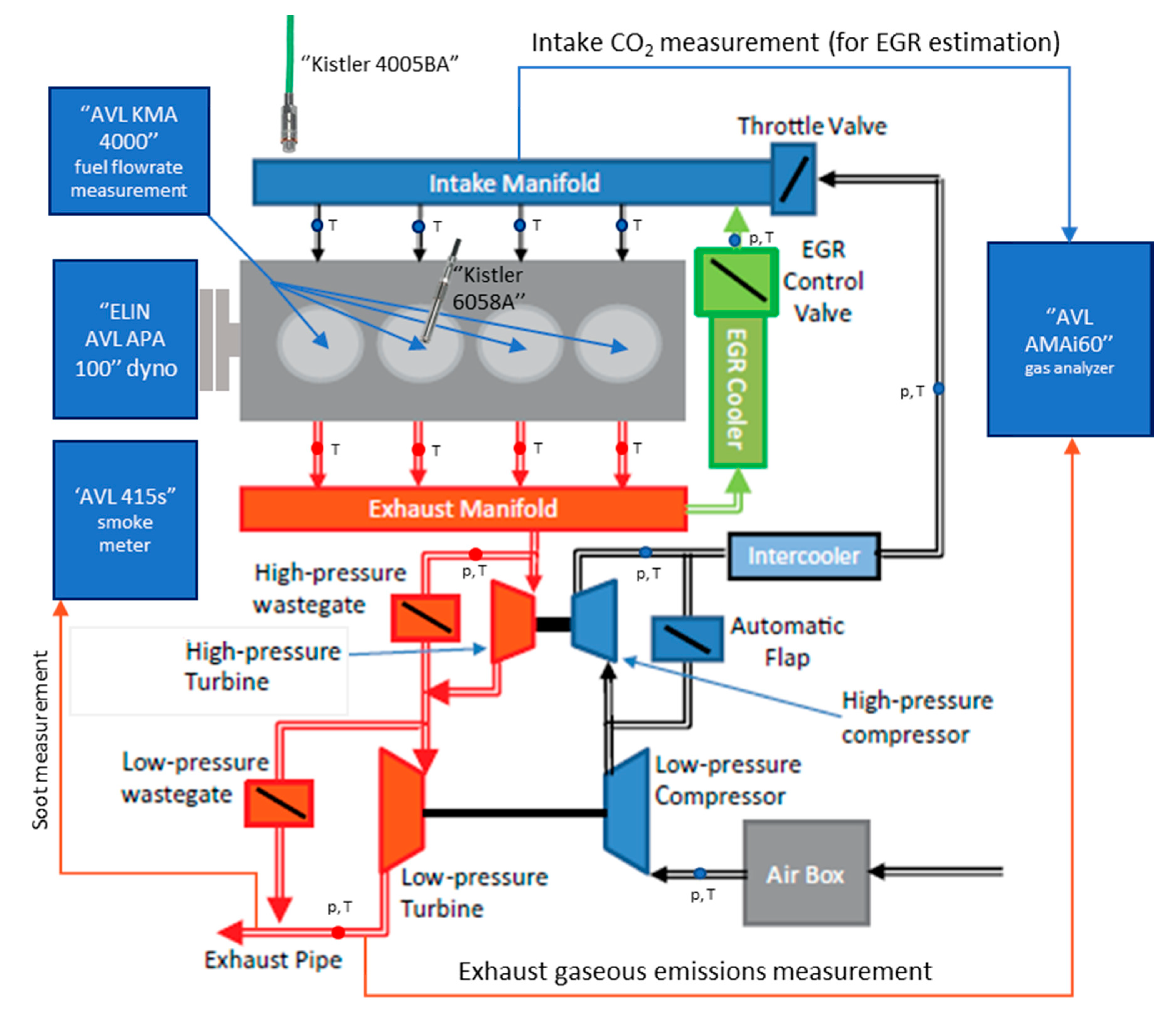
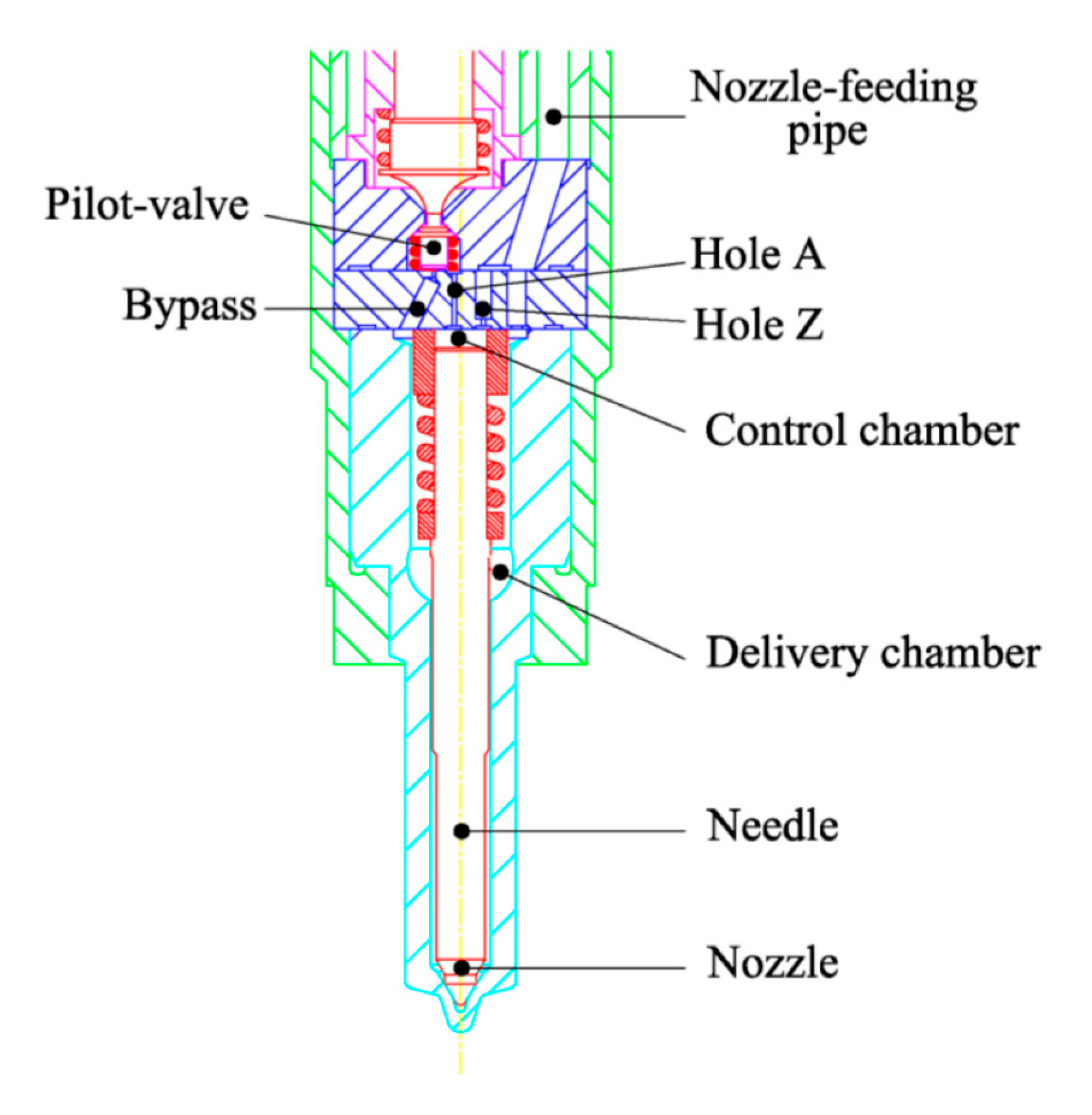
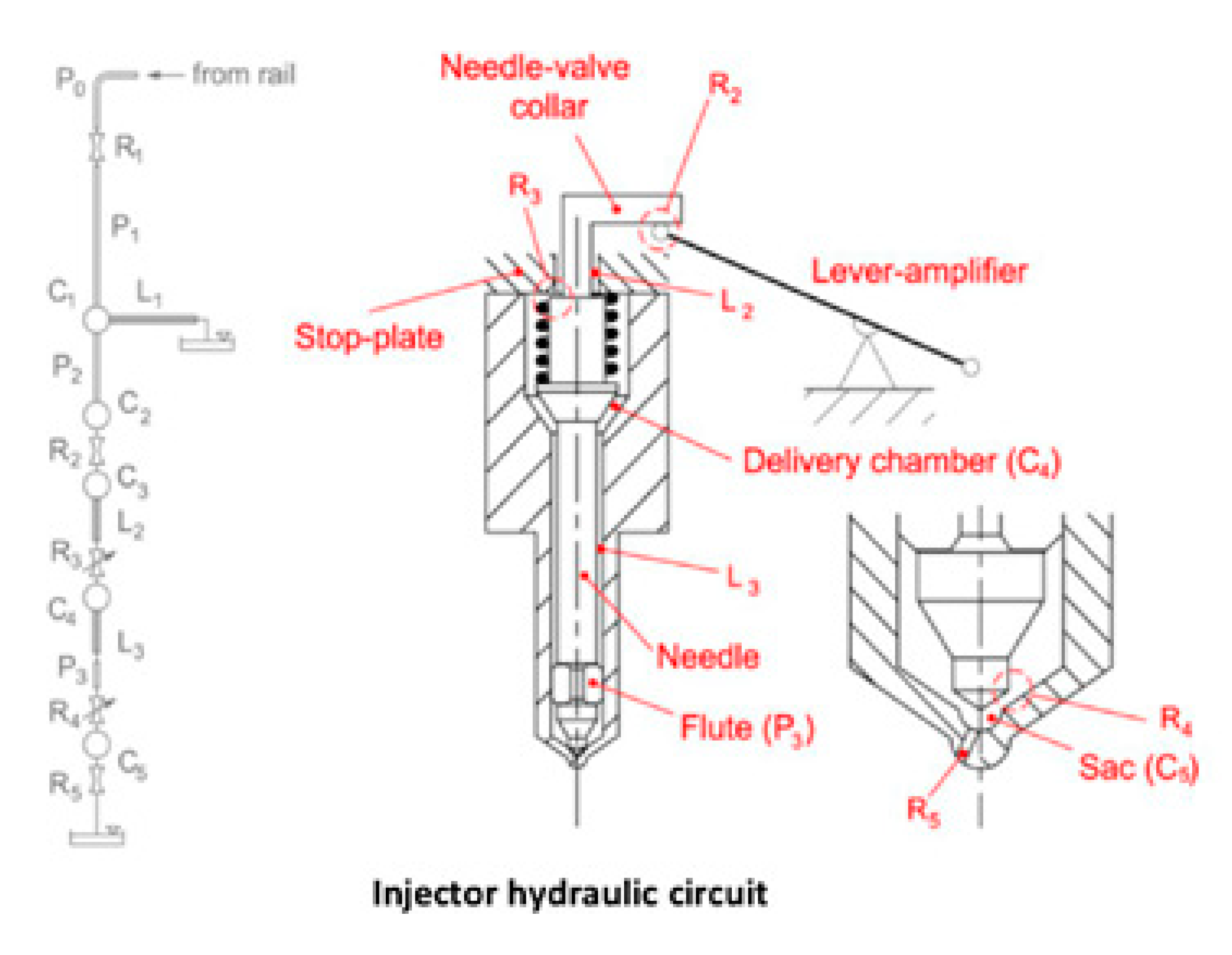

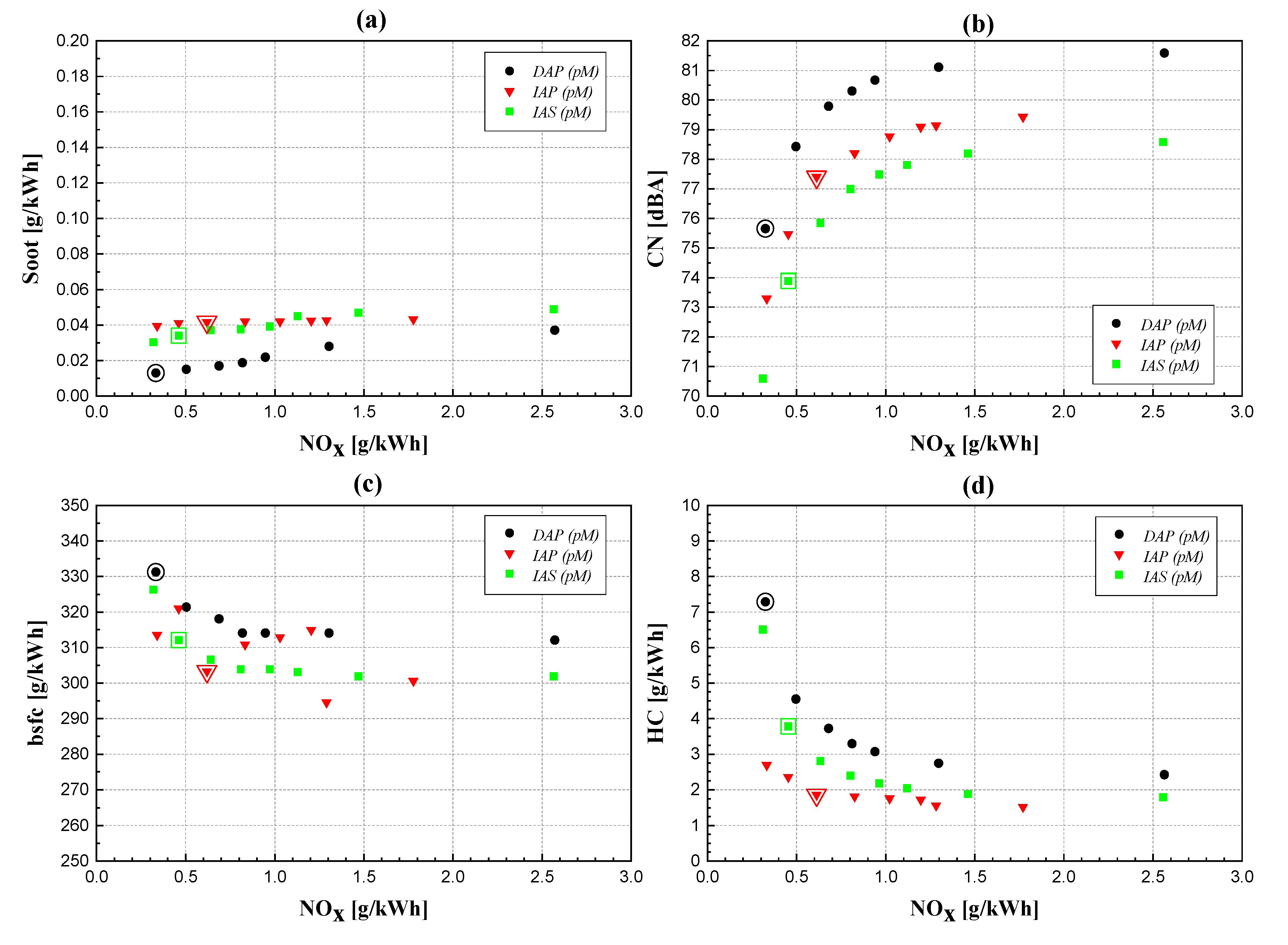
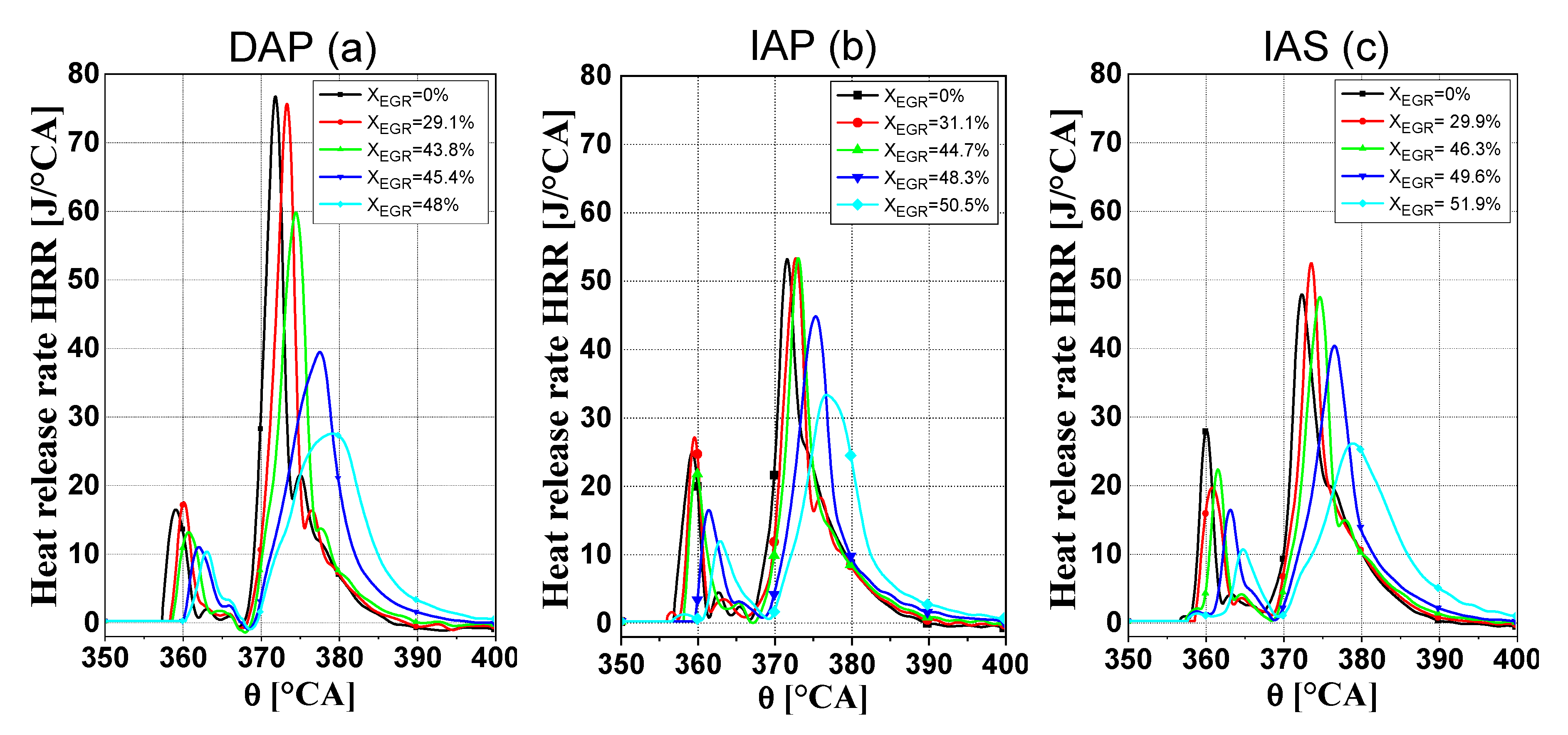
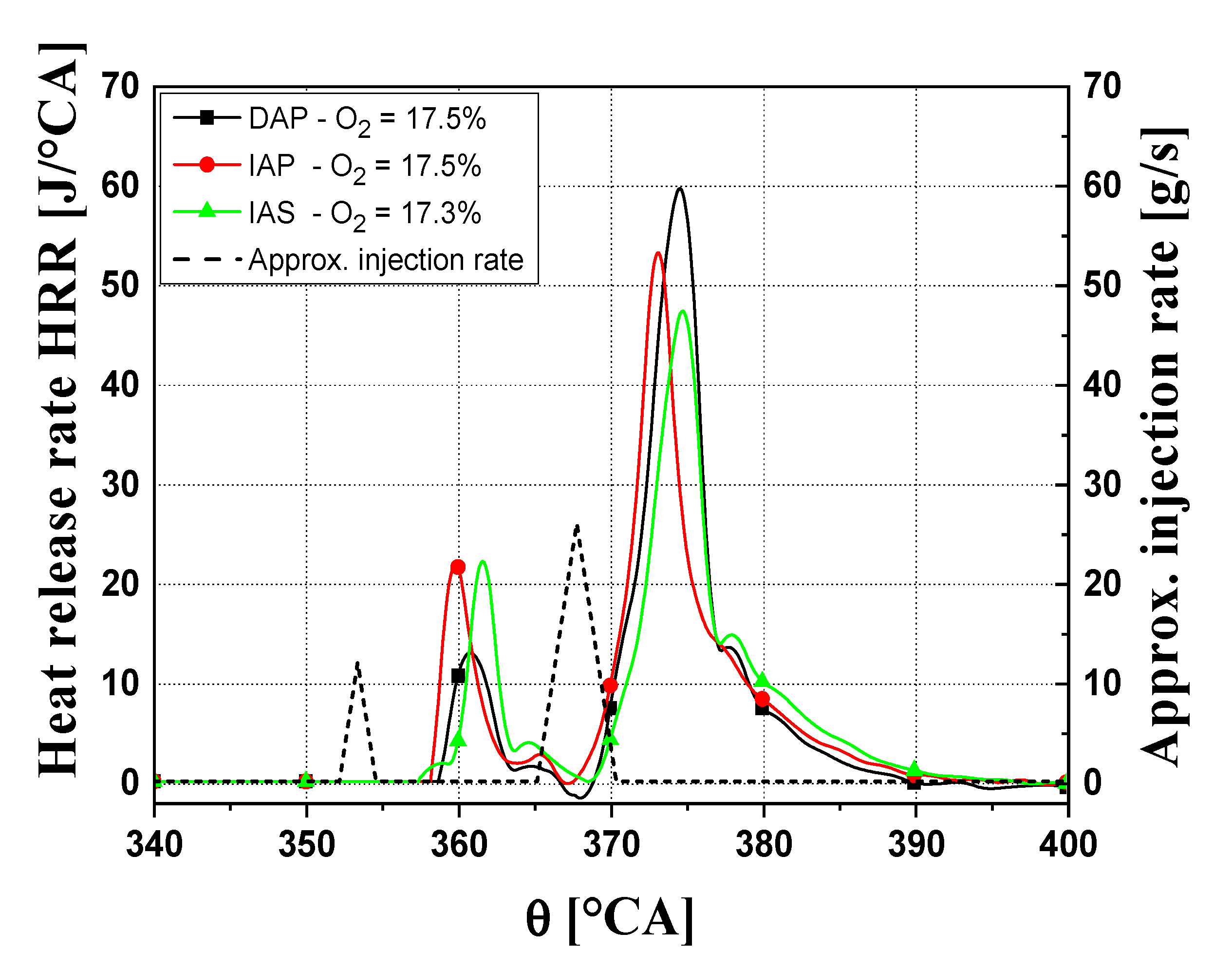


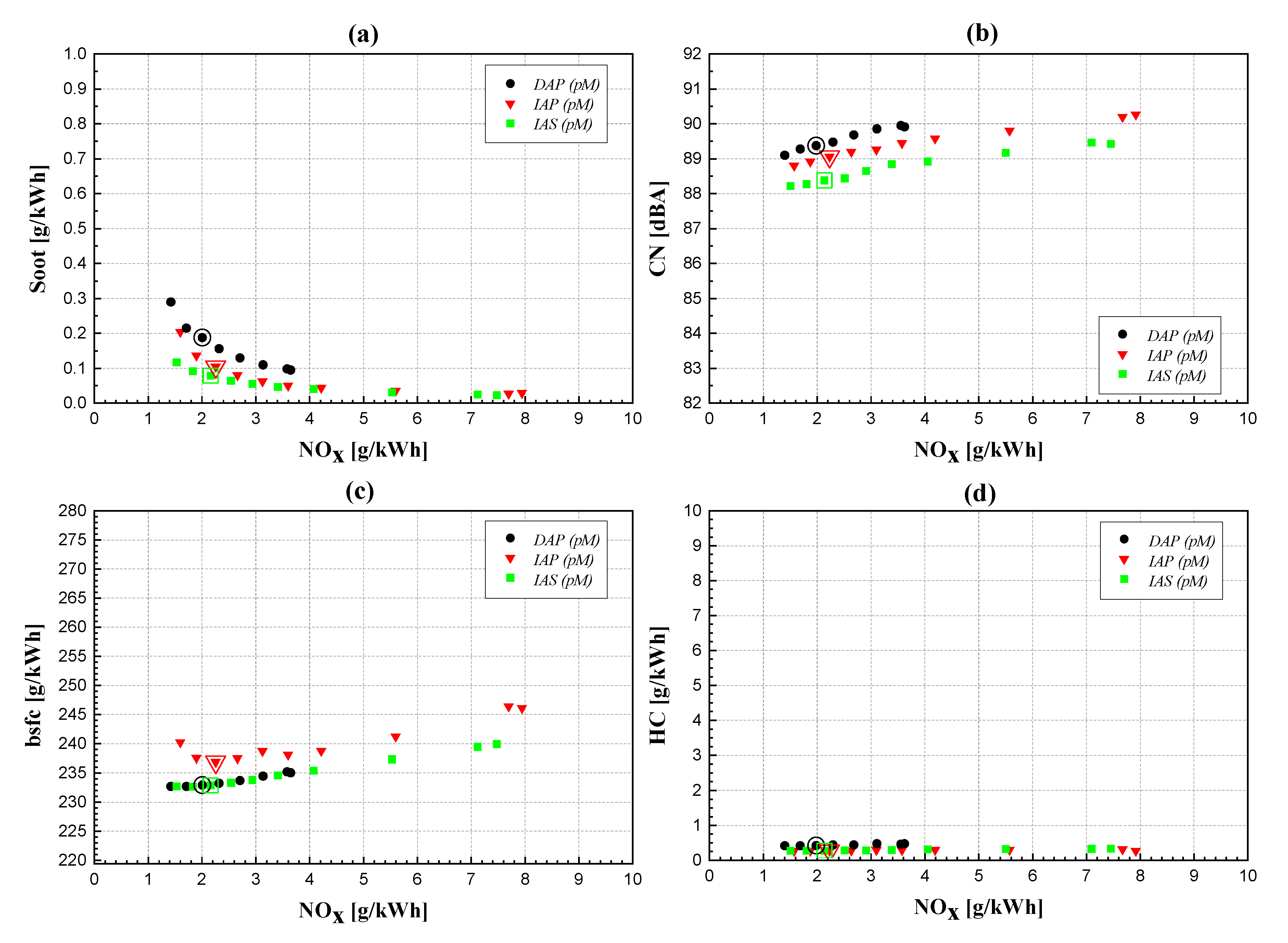
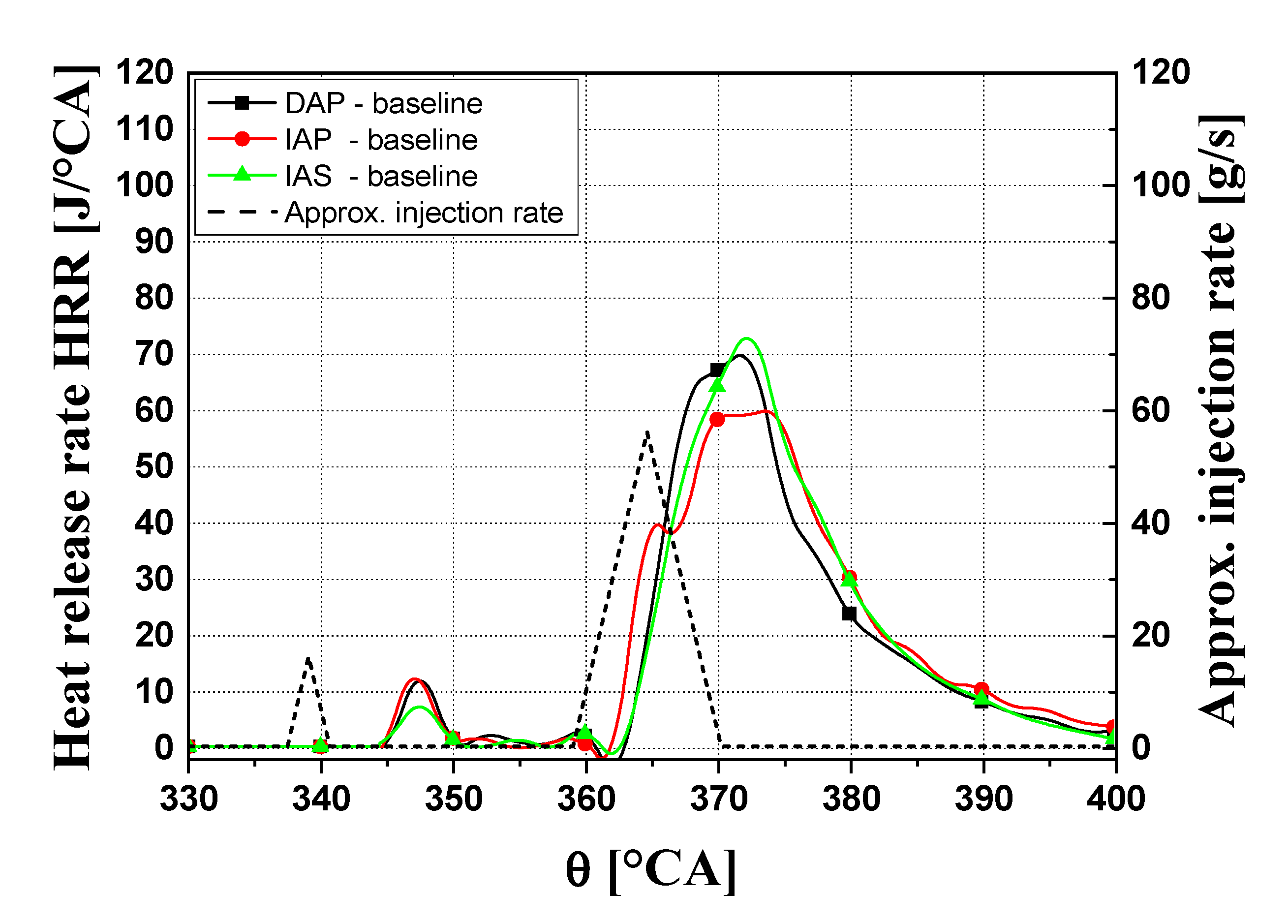
| Engine Specifications | |
|---|---|
| Engine type | 2.0 L diesel direct-injection Euro 5 |
| Number of cylinders | 4 |
| Displacement | 1956 cm3 |
| Bore × stroke | 83.0 mm × 90.4 mm |
| Compression ratio | 16.3 |
| Valves per cylinder | 4 |
| Turbocharger | Twin-stage with valve actuators and wastegates |
| Fuel injection system | High-pressure (max. 2000 bar) Common Rail |
| EGR system | Short-route cooled EGR |
| Composition of the Gas Calibration Cylinder and Extended Uncertainty | |
|---|---|
| NO (lower range) [ppm] | 89.7 ± 1.7 |
| NO (higher range) [ppm] | 919 ± 18 |
| CO (lower range) [ppm] | 4030 ± 79 |
| CO (higher range) [%] | 8.370 ± 0.097 |
| CO2 (lower range) [ppm] | 4.980 ± 0.067 |
| CO2 (higher range) [%] | 16.78 ± 0.15 |
| C3H8 (lower range) [ppm] | 88.8 ± 1.8 |
| C3H8 (higher range) [ppm] | 1820 ± 36 |
| Measurement Errors of the CLD, NDIR, and HFID Analyzers | |
|---|---|
| Linearity | ≤1% of full-scale range ≤2% of measured value whichever is smaller |
| Drift 24 h | ≤1% of full-scale range |
| Reproducibility | ≤0.5% of full-scale range |
| Quantity | Reference pM Injection Calibration by OEM, IAP Injector |
|---|---|
| SOIPil [°CA bTDC] | 10.6 |
| SOIMain [°CA bTDC] | −2.4 |
| ETPil [µs] | 250 |
| pRail [bar] | 450 |
| qPil [mm3/(stk·cyl)] | 1.7 |
| XEGR [%] | 47.5 |
| Quantity | Reference pM Injection Calibration by OEM, IAP Injector, 2000 × 5 | Reference pM Injection Calibration by OEM, IAP Injector, 2500 × 8 |
|---|---|---|
| SOIPil [°CA bTDC] | 15.2 | 23.6 |
| SOIMain [°CA bTDC] | −1.8 | 2.2 |
| ETPil [µs] | 190 | 155 |
| pRail [bar] | 750 | 1200 |
| qPil [mm3/(stk·cyl)] | 1.4 | 1.2 |
| XEGR [%] | 32.3 | 22.7 |
© 2019 by the authors. Licensee MDPI, Basel, Switzerland. This article is an open access article distributed under the terms and conditions of the Creative Commons Attribution (CC BY) license (http://creativecommons.org/licenses/by/4.0/).
Share and Cite
d’Ambrosio, S.; Ferrari, A.; Mancarella, A.; Mancò, S.; Mittica, A. Comparison of the Emissions, Noise, and Fuel Consumption Comparison of Direct and Indirect Piezoelectric and Solenoid Injectors in a Low-Compression-Ratio Diesel Engine. Energies 2019, 12, 4023. https://doi.org/10.3390/en12214023
d’Ambrosio S, Ferrari A, Mancarella A, Mancò S, Mittica A. Comparison of the Emissions, Noise, and Fuel Consumption Comparison of Direct and Indirect Piezoelectric and Solenoid Injectors in a Low-Compression-Ratio Diesel Engine. Energies. 2019; 12(21):4023. https://doi.org/10.3390/en12214023
Chicago/Turabian Styled’Ambrosio, Stefano, Alessandro Ferrari, Alessandro Mancarella, Salvatore Mancò, and Antonio Mittica. 2019. "Comparison of the Emissions, Noise, and Fuel Consumption Comparison of Direct and Indirect Piezoelectric and Solenoid Injectors in a Low-Compression-Ratio Diesel Engine" Energies 12, no. 21: 4023. https://doi.org/10.3390/en12214023
APA Styled’Ambrosio, S., Ferrari, A., Mancarella, A., Mancò, S., & Mittica, A. (2019). Comparison of the Emissions, Noise, and Fuel Consumption Comparison of Direct and Indirect Piezoelectric and Solenoid Injectors in a Low-Compression-Ratio Diesel Engine. Energies, 12(21), 4023. https://doi.org/10.3390/en12214023





